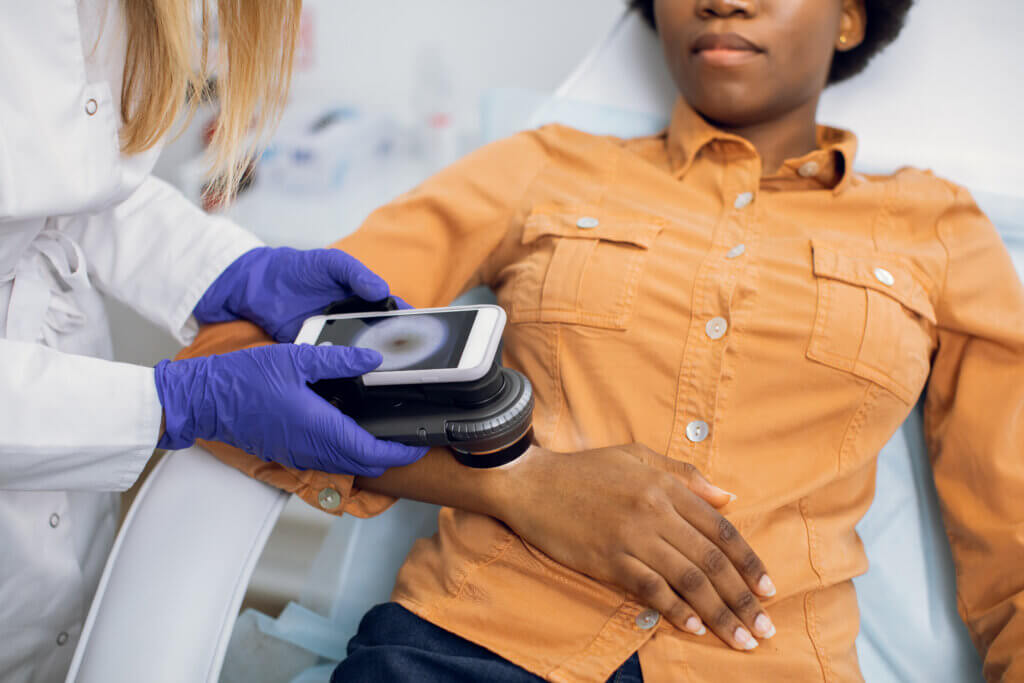
Can Melanoma Affect People of Color?
Written by: Lukas Harnisch-Weidauer
Melanoma, a type of skin cancer, gets its name from the pigment-producing cells called melanocytes from which tumors can develop. Melanocytes manufacture melanin, a substance in your body that produces hair, eye, and skin pigmentation. Melanin absorbs sunlight and helps to protect skin from DNA damaging ultraviolet light which can contribute to the development of cancer.
Although melanoma accounts for relatively few skin cancer cases compared to other skin cancers like squamous and basal cell carcinomas, it is a common cause of skin cancer deaths. Melanoma is easier to treat in earlier stages. This means awareness and early detection are especially important.
Does skin color affect melanoma risk?
The short answer is yes, but everyone should be aware of, and monitor for, skin cancer.
Because people with darker skin have more melanin, they are at lower risk of developing melanoma than those with light skin. The lifetime odds of developing melanoma are – according to one’s ethnicity:
- 3% (1 in 33) for white people.
- 0.1% (1 in 1,000) for Black people.
- 0.5% (1 in 200) for Hispanic people.
Ethnicity is complex, and many will not fit into a single category. Your sun reactivity is a more accurate indicator of your risk of developing skin cancer.
If you are very fair-skinned, with light or red hair, or have a lot of freckles, you are more susceptible to skin damage that can lead to skin cancers like basal cell carcinoma, squamous cell carcinoma and melanoma.
People who are less likely to burn, including people of color, are less at risk for skin cancers. But ultimately, melanin is not enough to protect you from the damaging effects of the sun. It is a common misconception that people of color do not get melanoma. People with darker skin tones are more likely to develop acral melanoma, a rare subtype of melanoma not caused by the sun.
Acral melanoma usually develops in areas that are not exposed to sunlight, like under fingernails or on the palms and soles of feet. Individuals with any skin type can develop melanoma, and it’s important to monitor your skin regardless of skin type.
The importance of early detection of melanoma
Early detection is key to melanoma treatment, the earlier it is caught, the greater likelihood of survival. Usually, the cancer begins on the skin. It can appear as a mole that has recently changed size, shape, or color. It can occur anywhere on the body, including, in some rare cases, on the eye and within the nose and throat.

Even though, melanoma is most common among white people, mortality rates are highest for people of color. This is because those cases are often caught at a later stage when the cancer has infiltrated the body and is no longer easy to remove surgically.
Awareness may be the key to reducing this disparity. Researchers believe it stems from the misconception that people of color are not at risk for skin cancers. These patients and their physicians may overlook melanoma symptoms and catch the cancer later.
How people of color can detect melanoma
Melanoma may look different among people of color and is often hidden. It is important to check areas of the skin that are usually hidden from the sun, including the soles of the feet, in-between toes, and palms of the hands, for new or changing moles. Skin cancer can also manifest on nails as a pigmented streak.
Doctors advise people of all skin types to:
- Wear sunscreen.
- Stay in the shade between 10 a.m. and 4 p.m.
- Regularly check your own skin including areas like the soles of the feet, in-between toes, palms of the hands, and nail beds.
- If you see something concerning, raise it with your physician.
- Have regular skin checks by a health professional.
For more information, please visit the Dana-Farber Cancer Institute booth.
Source: Read the complete article

